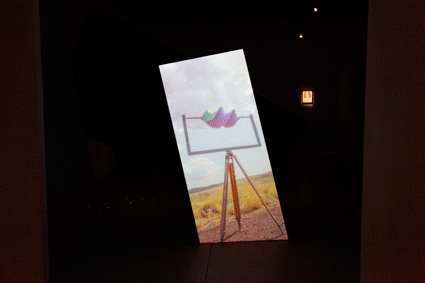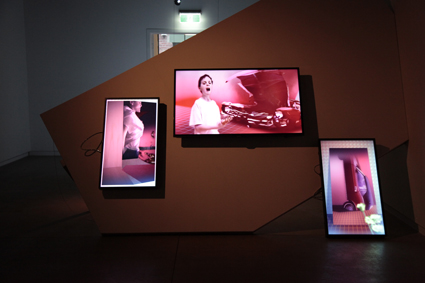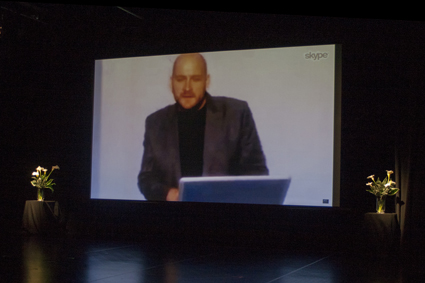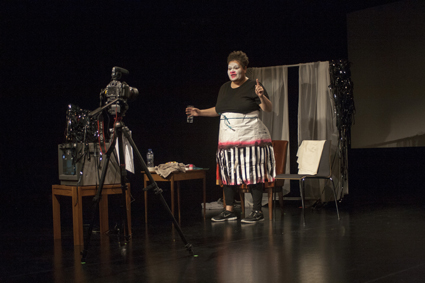Video art now through the lens of then
Urszula Dawkins, Channels Video Art Festival

Benjamin Ducroz, cumulo, installation
photos Eugenia Lim
Benjamin Ducroz, cumulo, installation
For an ‘inaugural’ artist-led festival based around a relatively young art form, the Channels video art festival was weighty: a packed four-day program including close to 100 artists, curators and speakers; a level of curatorial and critical engagement that significantly amplified the impact of the work itself; and not least, a substantial printed catalogue that ably focused ideas, themes and relationships across the program.
Encompassing gallery-based installation, projections, online broadcast, a voluminous screening program and public talks, Channels’ central question was, say co-directors Rachel Feery, Eugenia Lim and Jessie Scott, “What is video art now?” Sounds simple, even simplistic—but one of the many impressive things about Channels was its genuine consideration of the question: its showcasing of contemporary video work with reference to the history of the form and a conscious engagement with the ubiquitous ‘now’ of mass-media video immersion.

Ms&Mr, Amputee of the Neurotic Future 1988/2012, installation
photo Eugenia Lim
Ms&Mr, Amputee of the Neurotic Future 1988/2012, installation
Installed
Transformer, at Screen Space, was the exhibition for Channels, featuring works commissioned from Ms&Mr (aka Australian-Canadian duo Stephanie and Richard nova Milne) and Melbourne-based Benjamin Ducroz. In Ducroz’ cumulo, piles of roiling Pilbara storm clouds dissolve into the incremental movements of a hand-cranked, helical kinetic sculpture. Both phenomena are filmed in stop motion, in the landscape; but while the sped-up movement of the clouds is familiar thanks to its TV-doco ubiquity, the brightly coloured sculpture, stark in the middle of the desert, is surreal, seeming almost to be superimposed. Shifting between romanticism and deconstructivism, cumulo is projected onto a tall, trapezoidal screen at the gallery entrance accompanied by a soundtrack of ambient, insecty, subtle, sometimes ominous tones. The sublime vision of clouds—creamy, silver-lined or darkly grey—prefigured the misty pines and crumbling glaciers of some of the more meditative works in Channels’ Video Visions screening program. At the same time, the stepped structure and block colours of the moving model insist on time’s breakdown into increments, dancing with the origins of time-based photography. If it weren’t for Ducroz’ process work in the nearby foyer, where the sculpture is seen ‘on set’ in the desert, the quasi-scientific, twirling helix could easily be read as a 3D animation. In a sense, romantic ‘truth’ meets disbelief in cumulo.
A warping, monotonal drone is the backdrop for Ms&Mr’s three-channel work, Amputee of the Neurotic Future 1988/2012, part of their ongoing Videodromes for the Alone series. A distressed and silently howling prepubescent boy is protagonist in a fractured world of film and 3D animation, surrounded by symbolic props—a crashed and sinking car, a hospital gown apparently animated from within, a CAD-drawn checkered floor, an uncannily defocused bunch of flowers. With references to both J G Ballard and David Cronenberg, the mood is dystopian, painful and alienated, but washed out by blood-red monochrome into a kind of emotionless absence: an escape from horrifying realities that itself becomes horrifying.
Screened
The main screening program, Video Visions, provided an astonishingly broad survey of current video art from Australian and international artists over two intensive sessions on one night. Loosely themed into four sections—Sensory Drive, Media Mash-Ups, Constructed Worlds and Bodies Collide—Video Visions included dozens of short works; the choice to include an interval in each session created just the right breathing space.
There’s not enough room here to describe the breadth of works in the Video Visions program but some overall themes were evidenced, both in the overarching session titles and more subtly. The Media Mash-Ups and Bodies Collide sessions were the most tightly focused and, interestingly, the most reliant on humour, as though both the onslaught of mass culture and our visceral, physical reality can only be confronted with a grimace or an outright laugh. Sensory Drive crossed from virtuosic, psychedelic experiments with CGI ‘super-natures’ to formalistic explorations of colour, line or natural phenomena. Narrative seemed to emerge most strongly in Constructed Worlds, as though a ‘world’—even a fictitious or abstract one most requires a story. Noticeably weaving throughout the program were frequent evocations of mysticism and suggestions of what seemed like ‘earth-nostalgia:’ conflations of human/nature; eerie, hollow and ominous soundtracks; and the sense of worlds lost.

Emile Zile, Random Name Generator Memorial Roll Call, Memory Screens
photo Danielle Hakim
Emile Zile, Random Name Generator Memorial Roll Call, Memory Screens
Performed
The intersection between video and performance art, past and present, was the inspired starting point for the Memory Screens program in which artists Salote Tawale, Hannah Raisin and Emile Zile each presented newly commissioned works paying homage to selected iconic works by video and performance “elders.” As well as live performances of the three new works, excerpts were screened both from the artists’ previous output and from the chosen ‘source’ works.
Emile Zile, whose work to date humorously interrogates and replays conventions and tropes of cinema, television and the web, chose as inspiration Ant Farm’s 1975 Media Burn in which a Cadillac smashes through a pile of burning TV sets. In the most oblique response of the three artists, his new performance (via Skype), Random Name Generator Memorial Roll Call, comprised a tongue-in-cheek, funerary video roll call of randomly generated, unborn internet users, accompanied by vases of white lilies.

Hannah Raisin, Dear Carolee, Love Cindy, Love Hannah, Memory Screens
photo Danielle Hakim
Hannah Raisin, Dear Carolee, Love Cindy, Love Hannah, Memory Screens
Hannah Raisin, responding to Carolee Schneeman’s Interior Scroll, chose Cyndi Lauper’s “Girls Just Wanna Have Fun” as soundtrack to her absurd and confronting consumption of raw eggs injected with coloured dyes. Echoing Schneeman, whose 1975 performance consisted of extracting a long scroll from her vagina, in Dear Carolee, Love Cindy, Love Hannah, Raisin provided the music via an audio cable drawn from her vagina (presumably attached to an inserted MP3 player) and plugged into a stage monitor. The effect blurred feminist statement and monstrous-feminine, hinted at porn and vigorously challenged the gaze.

Salote Tawale, Dressing Up, Memory Screens
photo Danielle Hakim
Salote Tawale, Dressing Up, Memory Screens
Most directly referential was Salote Tawale’s response to Susan Mogul’s 1973 video, Dressing Up. As she slowly gets dressed, Mogul delivers a monologue on the clothes her mother made her wear as a child while periodically stuffing her mouth with snack food. Tawale recreated Dressing Up, delivering her own story of childhood female oppression, inextricably woven with the threads of her Pacific Islander heritage. It was a powerful end to a session that exemplified the strengths of Channels overall: its engagement across a broad thematic range, critical depth through discussion, and the commissioning of new work; and the imaginative contextualising of contemporary practice through the lens of history.
Channels: The Australian Video Art Festival, various venues, Melbourne, 18–21 Sept; http://www.channelsfestival.net.au/
This article first appeared in RT’s online e-dition 23 Oct, 2013
RealTime issue #118 Dec-Jan 2013 pg. web






